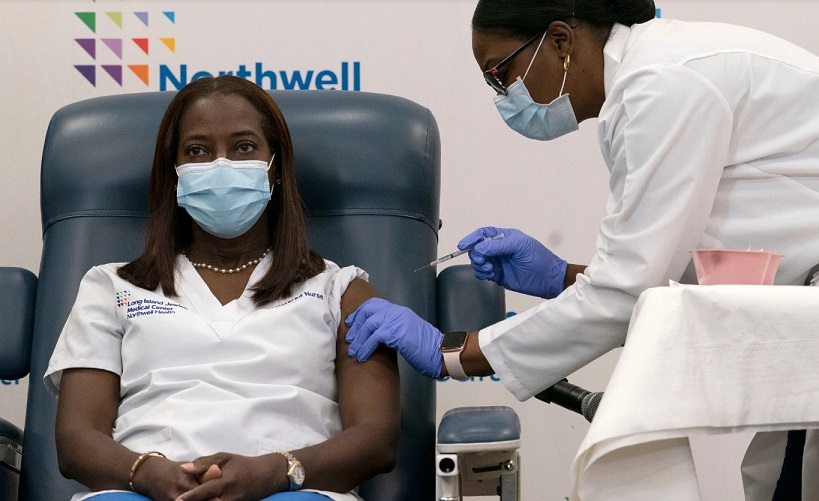The first shots were given in the American mass vaccination campaign on Monday, opening a new chapter in the battle against the coronavirus pandemic, which has killed more people in the United States — over 300,000 — than in any other country and has taken a particularly devastating toll on people of color.
NYTimes: Shortly after 9 a.m., the new Pfizer-BioNTech vaccine was administered at Long Island Jewish Medical Center in Queens, the first known inoculation since the vaccine was authorized by the Food and Drug Administration late last week.
It was a hopeful step for New York State, which the virus has scarred profoundly, leaving more than 35,000 people dead and severely weakening the economy.
“I believe this is the weapon that will end the war,” Gov. Andrew Cuomo said shortly before the shot was given to Sandra Lindsay, a critical care nurse at the center.
State officials said the shot was the first to be given outside of a vaccine trial in the United States.
Lindsay, who has treated patients throughout the pandemic, said that she hoped her public vaccination would instill confidence that the shots were safe.
“I have seen the alternative, and do not want it for you,” she said. “I feel like healing is coming. I hope this marks the beginning of the end of a very painful time in our history.”
President Trump posted on Twitter: “First Vaccine Administered. Congratulations USA! Congratulations WORLD!”
Shortly afterward, Mayor Bill de Blasio of New York City said at a news conference: “To me, we were watching an incredibly historic moment, and the beginning of something much better for this city and this country.”
In Iowa City, Iowa, David Conway, a 39-year-old emergency room nurse, received the vaccine, and in Columbus, Ohio, Dr. Mark Conroy, 41, an emergency medicine physician, did, too.
“It was pure excitement on my part,” said Dr. Conroy, the medical director of the emergency department at Ohio State University Hospital, who added that he had lost friends to the virus.
The vaccinations started after the F.D.A.’s emergency authorization of the Pfizer-BioNTech vaccine on Friday night, and as the U.S. coronavirus death toll surpassed another dire milestone on Monday, with a steady surge in new cases daily.
On Sunday, trucks and cargo planes packed with the first of nearly three million doses of coronavirus vaccine had fanned out across the country, as hospitals in all 50 states rushed to set up injection sites and their anxious workers tracked each shipment hour by hour.
But the rollout is less centralized in the United States than in other countries that are racing to distribute it.
Across the country, according to Gen. Gustave F. Perna, the chief operating officer of the federal effort to develop a vaccine, 145 sites were set to receive the vaccine on Monday, 425 on Tuesday and 66 on Wednesday.
A majority of the first injections given on Monday are expected to go to high-risk health care workers.
In many cases, this first, limited delivery would not supply nearly enough doses to inoculate all of the doctors, nurses, security guards, receptionists and other workers who risk being exposed to the virus every day.
Because the vaccines can cause side effects including fevers and aches, hospitals say they will stagger vaccination schedules among workers.
Residents of nursing homes, who have suffered a disproportionate share of Covid-19 deaths, are also being prioritized and are expected to begin receiving vaccinations next week.
But the vast majority of Americans will not be eligible for the vaccine until the spring or later.
In an interview today, Dr. Anthony Fauci, the nation’s top infectious disease expert, laid out a timeline for a return to normalcy that stretched well into 2021.
He stressed that until then, social distancing and masks will remain crucial in the fight to stop the spread of the virus.
He predicted that the average person with no underlying conditions would get the vaccine by the end of March or beginning of April.
If the campaign is efficient and effective in convincing people to get the vaccine, most people could be vaccinated by late spring or early summer, he said.
“I believe we can get there by then so that by the time we get into the fall, we can start approaching some degree of relief, where the level of infection will be so low in society we can start essentially approaching some form of normality,” he said.
Until then, he stressed, the standard public health measures — distancing, masks, avoiding indoor gatherings — remain necessary.
“A vaccine right now is not a substitute for the normal standard public health measures,” he said, adding, “It’s not a substitute. It complements it. Only when you get the level of infection in society so low that it’s no longer a public health threat, can you then think about the possibility of pulling back on public health measures.”
The Trump administration is rushing to roll out a $250 million public education campaign to boost confidence in the vaccine.
The rollout was delayed for weeks because of concerns that the campaign had become politicized.
The vaccinations in the United States come six days after Britain became the first nation in the world to begin rolling out a fully tested vaccine.
Since then, a handful of other nations have approved the same vaccine.
In Canada, the first shipments of the Pfizer-BioNTech vaccine arrived on Sunday, Prime Minister Justin Trudeau announced on Twitter, and the first shots could be given as early as today.
